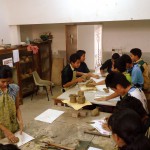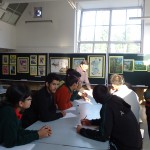Dialogue For Peace builds its third bridge by bringing together young adults from The Kashmir Valley and the North East India at the Assam Valley School, Tezpur.
A 7 day long workshop designed to facilitate interaction between two groups of young adults—inspiring them to envisage a safer, better world where people live with mutual respect and tolerance towards differences. Meeta Vashisht, eminent theater, television and film actor conducted the first three days of the workshop.
DAY 1. 30th January 2012: The Assam Valley School offered a delightful and magnificent lush space to conduct the workshop. An art and craft session was designed as the first platform for interaction between the participants on day one of the workshop. Inhibitions and hesitations were quite at the forefront while they sketched and molded clay pots. Teachers from the school facilitated both these activities while PeaceWorks representatives looked on with apprehension written large on their faces. Apprehension over—how the session will go—will the youngsters be interested in all that we had planned for them—will they find a comfort level with their peers from AVS—will bonding take place—how long will it take.
Post the first activity, a special screening of Louis Malle’s film, “Goodbye, Children”,
was done, which was received differently by the youngsters. The film depicts blossoming of friendship between a Christian and a Jewish boy in a catholic boarding school in Nazi occupied France and it reaffirms that human relations can be built in spite of external conditioning and politicization. While for some kids the unabashed humorous representation of the boarding life was an instant connect, others did not relate to the film.
DAY 2. 31st Jan: A fresh new day began with Meeta meeting everyone.
To know the other it is important to know yourself first—and this was the premise that all the day’s activities were based on.
She began by exploring concepts of identity. Her question, ‘How do you know you are here?’ left most, wondering and taken aback. She introduced a series of simple but powerful exercises that explored the limits of the body interspersed with interaction and introspection. Learning to know and respect the body, which she calls a ‘multi-ritual temple’ that houses the soul, and being acutely aware of every breath was at the forefront during the entire morning’s session. The bones cramped and creaked and notwithstanding the grumbles, most of the travel stress and also the extreme consciousness and shyness was gradually lost.
The evening session had two activities where the children witnessed chemistry experiments, “fun with chemistry” being conducted by the school students and were able to view and observe the moon through a powerful telescope, an experience that was new for many. This was followed by indoor games. By now all the inhibitions and awkwardness were left behind and the Kashmiri girls tried their hand at Basketball for the first time and proved to be very good at it! And much to the relief of the PeaceWorks representatives, friendships were slowly but visibly developing.
DAY 3. 1st February: The third day included a series of physical and vocal exercises followed by a reflection and analysis of the previous day’s experiences and learning. Ms.Vashisht then narrated the story of Mullah Naseeruddin to the youngsters and instructed them to enact it in plays. The entire team was divided into groups, which took up the same story and enacted it in their own unique way. In the evening everyone came together for a brief tee-shirt printing workshop with CDT teacher Mrs. Priyanka Joshi. She gave a demonstration of the procedure and then gave all the participants a free hand to cut out stencils and print their names on their tee shirts. The tees bore the logo of AVS and PeaceWorks, which the kids had printed out themselves. The evening once again provided an opportunity for other sporting activities—cricket and horse riding being the most popular with all.
DAY 4. 2nd Feb: The fourth day was primarily spent on preparations for the performance of the seven different versions of the play before the entire school. An outdoor spot was chosen for the street performance, props were assimilated, costumes put together and rehearsals done. Ms.Vashisht had given each group a free hand in the interpretation of the story of Mullah Naseeruddin, and the one thing that all the participants excelled in was the humour that they injected in each of the performances. The audience was in splits and the message that ‘difference’ can be extremely engaging and interesting came across very strongly. A Tree planting activity and practice for a dance performance also happened in the evening. The idea of planting trees was to leave behind a living, growing presence of this interaction for many years to come.
DAY 5. 3rd Feb: Open jeep safaris, vagrant forest breeze, indolent rhinos, dry grass on fire, Siberian ducks, elephants and a vast vista of forest adorned the Kaziranga trip on the 5th day of the workshop. This trip clearly gave the children the scope to indulge in friendly conversations, exploring each other’s worlds, knowing about them and most importantly, thinking over what they saw and experienced. An entire day was donated to see the vastness of the forest and its wilderness and bask in it.
DAY 6. 4th Feb: After a rejuvenating day in the Kaziranga Forest, the 6th day was slated for a letter writing exercise and practice for a dance performance. The exercise began with a team building game in which 5 groups comprising students from AVS and Kashmir were asked to go from one end of the podium to another without putting their feet on the floor, but walking on pieces of paper that were placed on the floor, designed with the idea of teaching them to coordinate with one another. One of the major issues we have been struggling with after each of the Dialogue for Peace sessions is to keep up and maintain the communication between the youngsters once they go back to where they come from and their busy lives. Introducing the joys of writing letters in this world of electronic communication is a step towards sustaining the bond that is developed during the weeklong interaction.
The evening flowed into a relaxed and in-depth communication with the Kashmiri girls. Thoughts that were until now held deep inside surfaced and they spoke about how different their life back home was from the lifestyle of the girls they met and interacted with at the Assam Valley School. Good/bad, right/wrong—extremely subjective terms—we hope this interaction and exposure will enable the Kashmiri girls, coming from repressive circumstances, make informed choices for their lives and their future.
DAY 7 5th Feb: The workshop culminated in a visit to the tea estates surrounding the vast stretch of the school campus, and with the performances of the children. As the time for the final performance had come, the dancers, speakers and elocution of a self composed poetry by Ryan was fitting way to formally round off all the activities and bring it to a gratifying and immensely enjoyable conclusion.
At one level, universally youth have more or less similar concerns, and yet their background, their environment and their circumstances can make them so different. Dialogue for peace – The Kashmir Project hopes this platform of interactions brings these differences to the surface and leads to an understanding and respect for them.
Dialogue for peace – The Kashmir Project hopes this platform sensitizes the privileged group and gives the not so privileged group the strength to make informed choices.
The young adults from Kashmir came face to face with freedom with which their peers lived and expressed themselves elsewhere. One hopes that it would help them question and challenge some of the societal inhibitions imposed on them. The seeds of it were already visible in Razia who was unhappy with the fact that she was allowed for this trip only because her brother accompanied her. The lives led by her peers from AVS perturbed her. Yet one is confident that once this whirlpool of impressions settle down, she and all the others, would be able to retain all that is relevant to them individually and take inspiration from it to shape their future.









